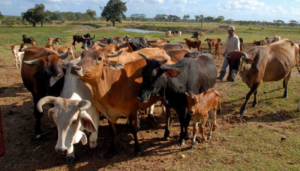
Cuba develops extensive programs for the recovery of livestock, based on the use of endogenous resources and the infrastructure developed in this branch, which, at the end of May, accounted for 3,621,489 head of cattle in the country, according to information from the Directorate of Livestock of the Ministry of Agriculture (MINAG).
According to the details of Alain Rodríguez López, General Director of the Livestock Directorate of the Ministry of Agriculture (MINAG), one of the first steps for the recovery of the livestock program is the selection in the country of 433 intervention scenarios to develop the technologies that guarantee the establishment of livestock in a sustainable way and as a guide for the recovery process, of which 224 belong to the Minag and 209 from Grupo Azucarero (AZCUBA), distributed in all the provinces.
In addition, 175 heifer development centers were created as a fundamental element for the increase in the productive indicators and the growth of the mass. In addition, work is being done on the selection of 10 advanced producers in each municipality to develop and transmit management and exploitation technologies.
In correspondence with the above, the planting plan for the year 2022 is 65 428.1 hectares —of which 8 606.9 hectares of Protein Forage Plants— and shows a growth of 14.6%, compared to the real reported in the year 2021; and in the case of Protein Forage Plants, a growth of 46.9% is planned in relation to the real obtained in 2021.
The change in the possession of the cattle, poor management of the mass, inadequate tenure conditions, loss of the control systems of the productive base and lack of demand to comply with the authorized norms by the legal and natural owners that show fissures that affect the mass control, are among the main problems detected, according to details by Ernesto Gómez Caballero, director of Genetics and Mass Control at Minag.
On the other hand, work is being done on the progressive computerization of herd control from the producer to the nation with the introduction of new technologies for basic, individual, sanitary control and the traceability of large cattle, prioritizing genetic herds in the first stage and racial; it is indispensable. Thus, measure 60 on accelerating the computerization of processes in the sector is fulfilled.
In this regard, there are 728 Livestock Registry Offices in 162 of the 165 municipalities that have registered large livestock, located near the owners and main herds in the People's Councils. Also, equipment (Laptop) was delivered to 139 municipalities, except for the provinces of Mayabeque and Artemisa, which allowed an initial load in EXCEL of all the characteristics of the owners and the national livestock mass.
Specialists in the sector describe the work with the Group of the Electronic Industry, Information Technology, Automation and Communications (GELET) as innovative in technical and organizational aspects for the individual electronic identification of cattle, for which it is intended to conclude in 2023 with the Livestock census carried out on 100% of the animals.




